Aconitum carmichaelii
Divine blue flowers are rare in the fall garden, but have we got a showstopper for you!
Azure monkshood is a perennial flower with stunning purple-blue blooms and entrancing foliage, perfect for adding interest to a fall garden.
Though it prefers moist soil, it can grow in shade or sun.
And best of all, all species of monkshood are resistant to deer, rabbits, and most insects, thanks to the toxins they produce.

We link to vendors to help you find relevant products. If you buy from one of our links, we may earn a commission.
Aconitum carmichaelii is a member of the Ranunculaceae, or buttercup family, which includes clematis, hellebore, and columbine. It is also known by its synonym A. fischeri.
Common names include Chinese aconite, Carmichael’s monkshood, and wolfsbane.
Ready to learn more? Here’s what’s ahead in this article:
What You’ll Learn
Cultivation and History
An alpine meadow plant, azure monkshood has been grown for centuries for its flowers. It adds a lovely shade of deep purple and blue to a fall garden.
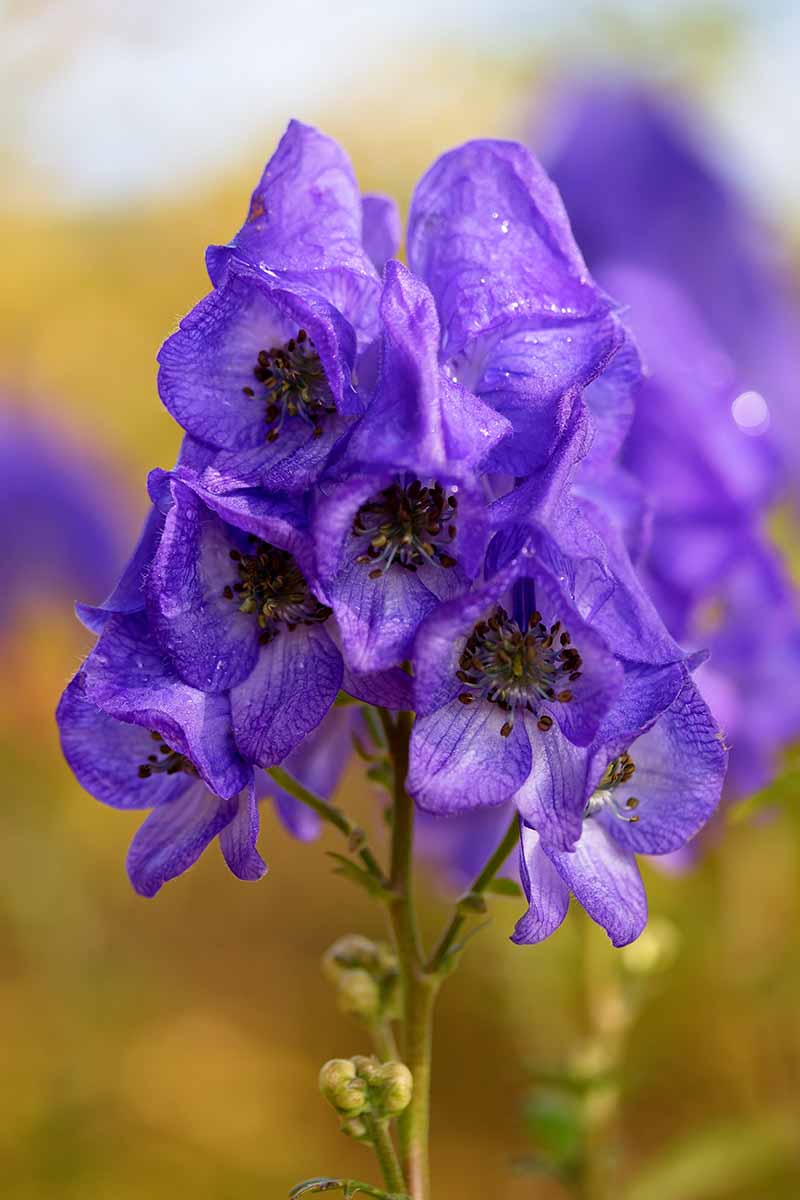
These charming flowers derive their common name from the hooded shapes of their blooms, resembling those of medieval monks. The hoods are deep purple, while the insides of the flowers are blue.
The flower stalks take the form of upright spikes that grow above the foliage. While azure monkshood is grown for its flowers, its dark green, toothed foliage is also attractive and unlike anything else in a fall garden.
This species is moderately difficult to grow and requires good soil preparation. The plants may take a while to become established, but they are well worth the trouble!
And as an added bonus, they are not aggressive or invasive.
Toxicity
Nature is anything but benign, and the natural world is rife with potentially fatal toxins in plants, fungi, and other forms of life.
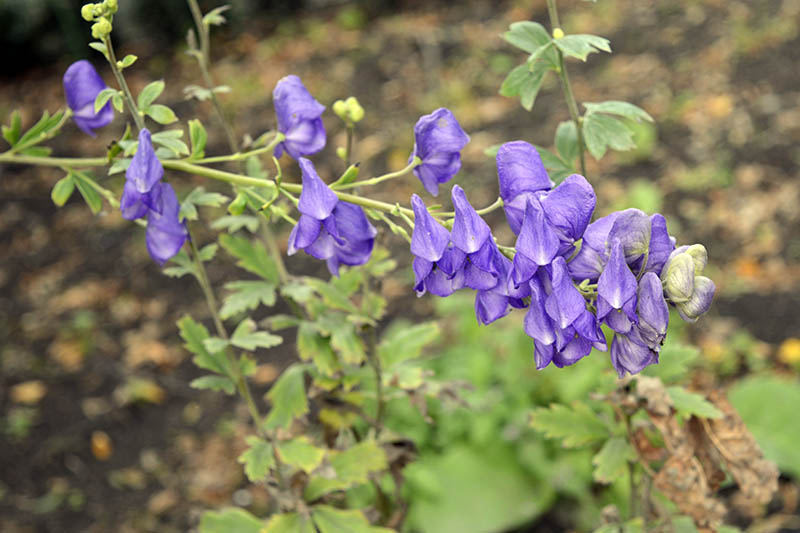
Just as beauty can hide a dark soul, the loveliness of azure monkshood belies its strong toxicity.
This plant produces the alkaloid aconitine, along with a number of other toxins. The roots and seeds are particularly toxic.
This species would fit well into one of those rare gardens designed entirely around poisonous plants.
However, most gardeners just want to enjoy the pretty flowers and take the appropriate precautions to prevent poisoning.
You should locate azure monkshood away from areas where children or pets could access it. It is also a good idea to locate it away from a vegetable garden where tuberous plants are growing.
Precautions to Take When Gardening
Although this species may seem as if it’s out to get you, it is much more likely that it evolved toxins to protect itself from being eaten by animals.
When you work with this perennial, you should wear disposable plastic gloves to protect yourself from the toxins. Skin contact alone has caused numbness in some cases.
Be sure to cover up any open cuts before you embark on gardening with these plants.
And wash your hands after any contact.
Uses for This Toxic Plant
Over the centuries, the toxicity of azure monkshood has been part of its allure. Aconitum, the genus name, is derived from the Greek word akoniton, which means “dart.”

A source of toxins for warfare – what’s not to love? According to old Chinese texts, extracts of this plant were used to poison arrowheads to kill opposing warriors.
And on a more practical lifesaving note, these poisoned arrows were also useful in hunting large animals for food.
Dried plants have been used by herbalists and in traditional medicine, but administration requires extreme caution, due to their toxicity.
Propagation
This perennial is not easily propagated, although it can be grown from seeds and root divisions.
You can sometimes find seedlings or transplants at your local garden center or nursery.
From Seed
Growing azure monkshood from seed is a labor of love. It is not an easy endeavor, unless you plant the seeds very soon after harvesting them.
You should sow the seeds in the fall or early winter for plants the following spring. The seeds need to be exposed to cold in order to germinate.
If you want to sow seeds in the spring, put them in water or moist soil and then freeze them for three weeks – this is a process known as cold stratification.
If you harvest seeds from existing plants and will not be sowing them immediately, you should store them in moist vermiculite.
However, the seeds can take as long as two years to germinate and may have a very low germination rate.
Another potential problem to keep in mind is that azure monkshood does not produce true to seed. If you collect your own seed from a specific cultivar, the seedlings may not be identical to the parent plant.
From Root Divisions
Another option to propagate azure monkshood is to divide the tuberous roots in the fall or spring.
Some experts advise against this and do not recommend disturbing the root systems in any way, as they are slow to become established.
It will take two to three years for the plants to mature from divisions.
Learn more about how to divide perennials in this guide.
Soil and Climate Needs
Azure monkshood prefers part shade but will grow in full sun, particularly in colder areas. Those planted in full sun locations will require more water.
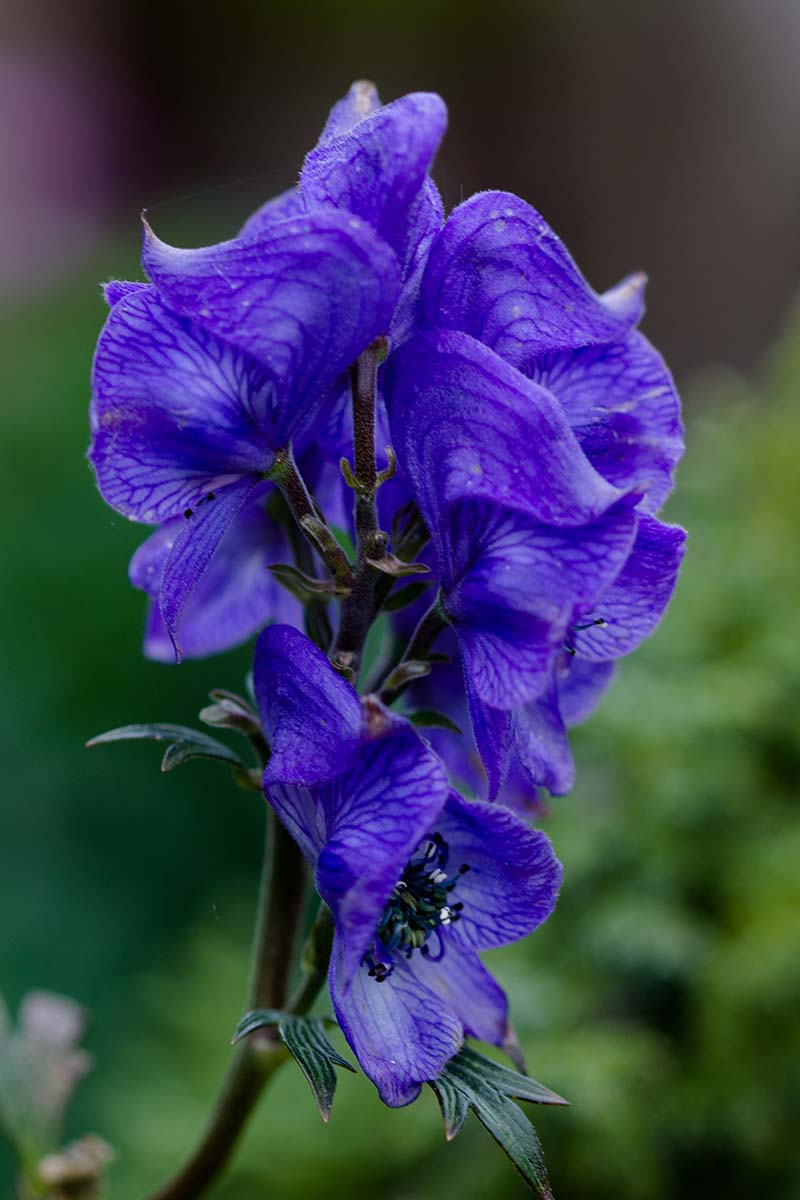
Like the other species of Aconitum, this one prefers to have its roots planted in humus-rich soil that stays moist but drains well.
Although this species will grow in a range of pH values, it prefers mildly acidic soil with a pH of 5.5-6.5. Conduct a soil test to determine the acidity and other qualities of the soil in your garden.
This perennial is suitable for gardeners in USDA Hardiness Zones 3-8, and possibly as far north as Zone 2.
It has been reported to grow in Zones 9 and 10. However, it will not thrive in areas with nighttime temperatures above 70°F.
How to Grow
Plant azure monkshood in a permanent location where you would like the flowers to grow, since this species is fussy and dislikes having its roots disturbed.
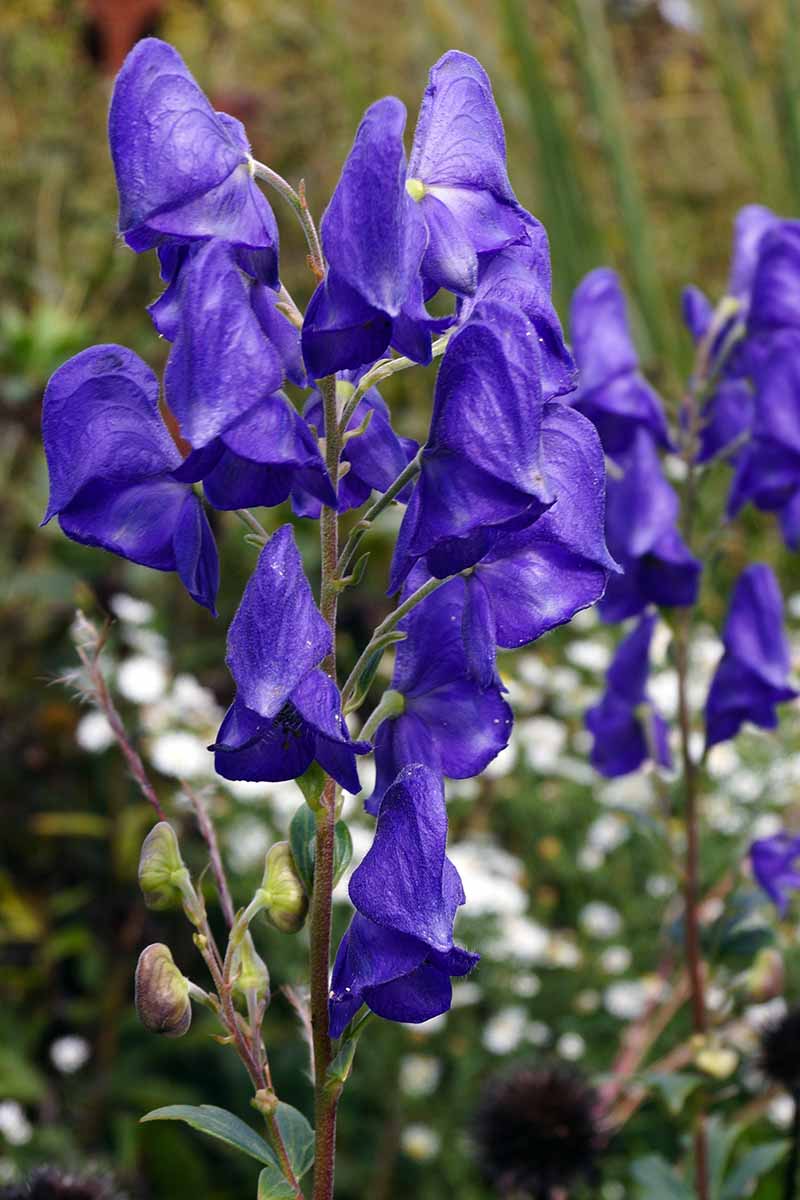
Before you transplant divisions or nursery starts, carefully prepare the soil and amend with organic matter.
While you can use compost, manure, or leaf mold, peat moss is ideal, since it is acidic.
Plant as soon as the ground is workable in the spring. Soak the root ball in water overnight before planting. Place the crown just below the surface of the soil.
If you are setting out nursery starts, plant to the same depth as the nursery containers.
Azure monkshood is like clematis and dahlias, in that it grows best with most of its leaves exposed to the sun, while keeping its roots cool.
Even when the plants are established, do not let the soil dry out completely between waterings.
Water deeply, rather than giving frequent, smaller drinks of water – and don’t allow the soil to become waterlogged.
Pruning and Maintenance
Most varieties will require staking. Put five-foot-tall stakes in the ground while the plants are still small, to avoid damaging the roots.
Deadhead the flowers after blooming to encourage additional blooms to form.
After it has finished flowering, you can also cut azure monkshood back by half to encourage the production of more flowers.
When flowering is finished for the season, cut plants back to the first set of leaves at the base of the stems.
At the end of the season, remove the stems and cover with four to six inches of mulch.
Learn more about winter mulching here.
Growing Tips
- Choose a permanent site to avoid transplanting later.
- Add organic matter to the soil.
- Make sure the soil drains well.
- Water deeply, when necessary.
- Wear disposable plastic gloves when you touch the plants.
Cultivars to Select
While numerous cultivars are available, two in particular stand out. Both ‘Arendsii’ and ‘Kelmscott’ were awarded the Award of Garden Merit from the Royal Horticultural Society.
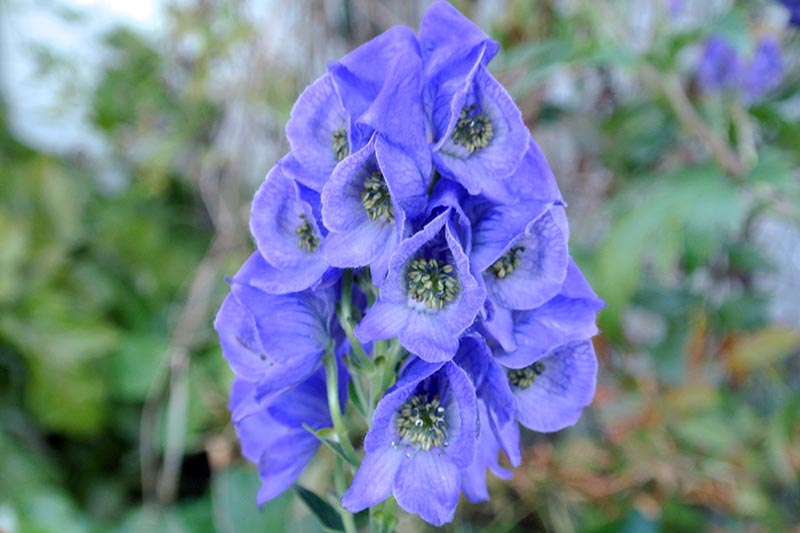
‘Arendsii’ was hybridized by German botanist Georg Arends in 1945. This cultivar grows taller and blooms later than most species of Aconitum.
It typically tops out at two to four feet tall, but it can grow as high as five feet when growing conditions are optimal.

‘Kelmscott,’ winner of the Award of Garden Merit in 1993, is grown for its lovely lavender-blue flowers. This cultivar grows to a mature height of up to five feet in ideal conditions.
Another option, ‘Royal Flush,’ has pure blue flowers and is shorter and more compact, with a mature height of just two feet.
Unlike the other cultivars of this species, its leaves have a deep red tint in the spring.
Managing Pests and Disease
Due to its toxicity, azure monkshood tends not to have many serious problems with pests or even deer, although a few insects can cause occasional problems.
Diseases are also rare.
Insects
Even toxic plants can be infested by insects that have become resistant to the host’s toxin. This process of adaptation is called coevolution.
Aphids
Azure monkshood is not likely to end up with an aphid infestation unless it is stressed, due to a lack of water.
You can wash aphids off with a strong blast from the hose, or use an insecticidal soap for heavy infestations.
Read more about aphids in the garden here.
Cyclamen Mites (Phytonemus pallidus)
You can tell if your plants have a mite infestation if the leaves are distorted, and the flower buds dry up before blooming.
You should immediately remove and destroy infected plants to prevent further spread.
Larkspur Leaf Miner (Phytomyza delphiniae)
The larkspur leaf miner is a type of small fly that lays eggs inside the leaves several times a year.
The maggots tunnel between the upper and lower leaf surfaces. This results in blotches on the leaves, and a heavy infestation can cause significant damage.
While you can apply insecticides to control this pest, there are also a number of natural parasites that will feed on the larkspur leaf miner.
If you choose to apply pesticides, you will kill the parasites as well, and end up trapped in a constant cycle of insecticide reapplication.
You can purchase the beneficial wasp Diglyphus isaea that homes in on the leaf miners and lays hundreds of eggs a year.
Packets of 250, 500, or 1,000 adults to release into your garden are available from Arbico Organics.
You can also reduce populations of leaf miners by handpicking the infested leaves and destroying them.
Removing all of the plant material at the end of the season and destroying it can help to reduce their numbers during the next growing season.
Read more about identifying and controlling leaf miners here.
Disease
Azure monkshood will not typically contract any diseases unless it is stressed by a lack of water. Keep an eye on your plants, especially during warm and dry weather, and maintain a regular watering schedule.
The most serious disease that may affect this plant is bacterial leaf blight, caused by the bacteria Pseudomonas syringae pv. delphinii.
This disease usually presents as shiny black spots on the top of the leaf surface, which may be brown on the underside. In the case of a bad infection, the spots may become larger and join together, causing large areas of the leaf to turn black.
If you see signs of this disease, immediately remove affected leaves and destroy them.
Best Uses
Azure monkshood is grown in borders for its flowers, although its novel green foliage makes it even more attractive in the fall garden.
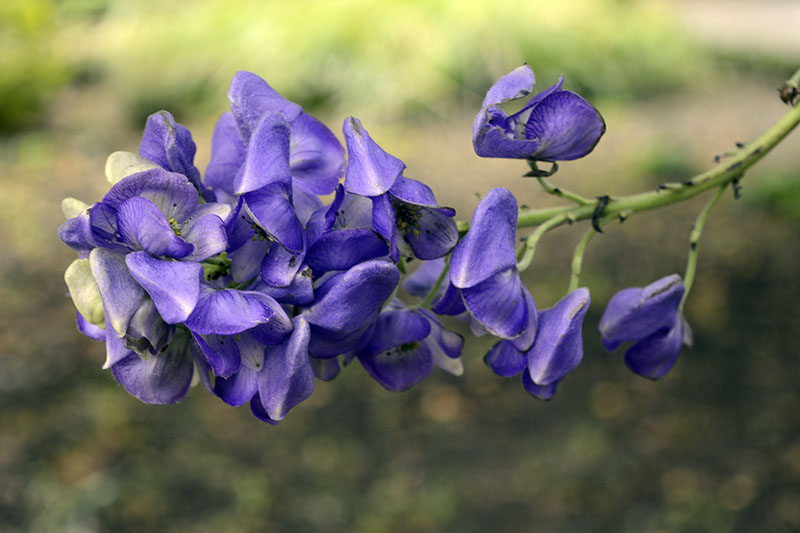
It performs well at the back of borders, providing height and textural interest.
Florists also use the long, elegant stems as a cut flower in arrangements.
Quick Reference Growing Guide
| Plant Type: | Perennial flower | Flower / Foliage Color: | Blue-purple/green |
| Native to: | China, Korea, Siberia | Tolerance: | Deep freeze |
| Hardiness (USDA Zone): | 3-8 | Soil Type: | Organically rich |
| Bloom Time / Season: | Fall | Soil pH: | 5.5-6.5 (ideal) will tolerate a range |
| Exposure: | Part shade, full sun in cooler areas | Soil Drainage: | Well-draining |
| Spacing: | 15-18 inches | Companion Planting: | Sedum, warm season grasses, Chrysanthemum ‘Cottage Apricot,’ C. ulginosum, Cimicifuga ramosa. |
| Planting Depth: | Depth of root ball | Uses: | Borders, cut flowers |
| Height: | 2-5 feet | Order: | Ranunculales |
| Spread: | 1-2.5 feet | Family: | Ranunculaceae |
| Water Needs: | High | Genus: | Aconitum |
| Maintenance: | Moderate | Species: | carmichaelii (syn. fischeri) |
| Common Pests: | Aphids, cyclamen mites, larkspur leaf miners | Common Disease: | Bacterial leaf blight, crown rot, powdery mildew, rust, Verticillium wilt |
A Stunning Purple-Blue Flower for the Fall Garden
Azure monkshood has a storied history of centuries of cultivation – and not all of it with murder in mind!
This alpine meadow plant blooms in the late summer and fall. While it is grown for its flowers, the lobed and toothed leaves are also highly attractive. And as it can grow up to five feet tall under optimal conditions, it is a good choice for the back of a flower border.
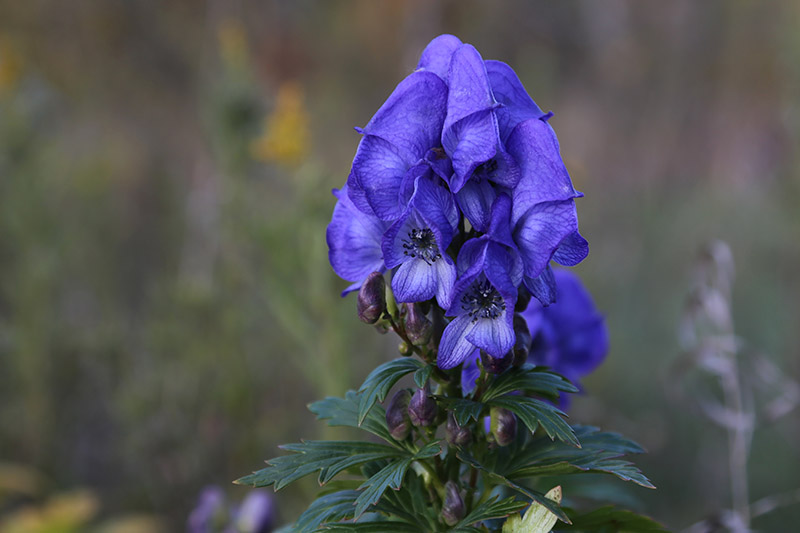
Since this plant is poisonous, locate it where children or pets cannot access it, and be careful when you handle it.
This perennial requires a lot of moisture, but it does not like soggy conditions. Don’t let the soil dry out completely between waterings, and you will be rewarded with stunning blooms.
Have you grown azure monkshood in your garden? Tell us about it in the comments below. And feel free to share a picture!
To learn more about growing flowers in your garden, try these guides next:
- 11 Native Blue Wildflowers for the Garden
- How to Grow Anise Hyssop: A Flowering Perennial Perfect for Borders
- The 15 Best Perennials for Fall Color
© Ask the Experts, LLC. ALL RIGHTS RESERVED. See our TOS for more details. Product photo via Arbico Organics. Uncredited photos: Shutterstock. With additional writing and editing by Clare Groom and Allison Sidhu.
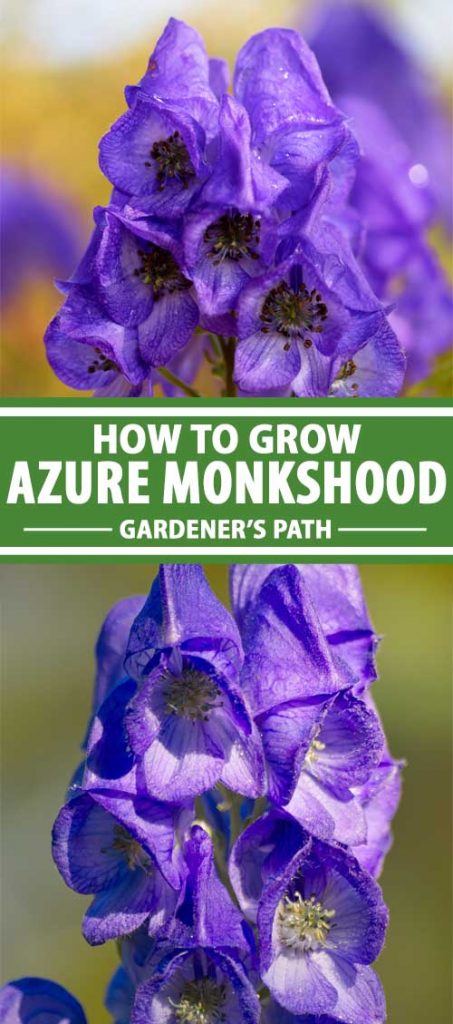





I actually wanted the more common Aconitum napellus but the nursery was out of it so I ‘settled’ for this. It arrived in a typical 4″ pot, small with beautifully ridged, rich green, maple-like leaves. It grew some over the next couple of months until it stopped mid-summer. I left it alone – as one should with any in this genus – only making sure to water it daily. In my climate zone (7b) with almost full sun, I could tell it wasn’t happy. I was hoping that the plants in front of it would provide enough shade but there… Read more »
Wow! That’s a great story Andy, and thank you for sharing! Must have been a big surprise after your plant had been languishing to suddenly see it come to life.